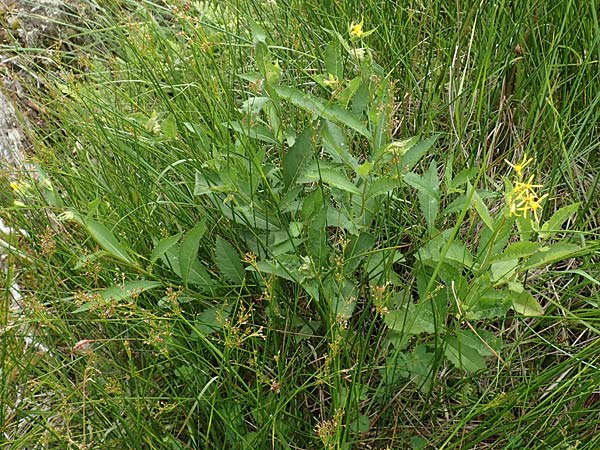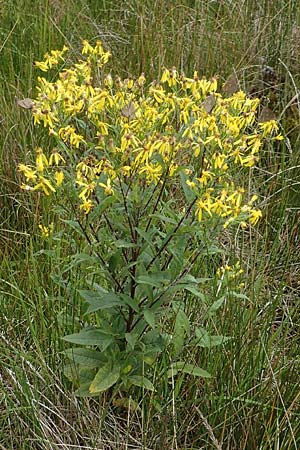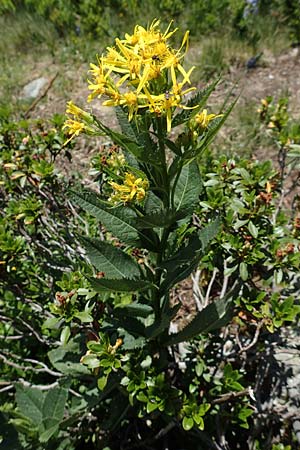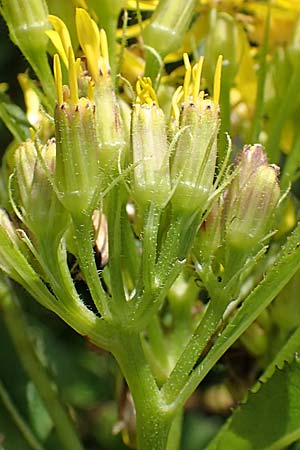| Navigation | Gattungsnamen können mit 3 Buchstaben abgekürzt werden, z.B. Bel peren | Genus names can be abbreviated by 3 letters, e.g. Bel peren | |
| Senecio hercynicus HERBORG |
| Fam.: Asteraceae \ Korbblütler / Composite Fam.
|
| Synon.: Senecio cacaliaster GUSS. ex DC. subsp. hercynicus (HERBORG) OBERPR., Senecio commutatus SPENN. var. nemorensis (L.) SPENN. |
| Gattung / Genus: Senecio L. |
| Autoren / Authors: | |||
| Joachim Herborg (fl. 1987), deutscher Biologe / German biologist | |||
| Giovanni Gussone (1787 - 1866), italienischer Botaniker / Italian botanist | |||
| Augustin-Pyrame de Candolle (1778 - 1841), schweizer Botaniker / Swiss botanist | |||
| Christoph Oberprieler (1964 - ), deutscher Botaniker / German botanist | |||
| Fridolin Carl Leopold Spenner (1798 - 1841), Botaniker in Freiburg (Deutschland) / botanist at Freiburg (Germany) | |||
| Carl von Linné (Linnaeus, 1707 - 1777), schwedischer Naturforscher, der das binäre Benennungs-System für Pflanzen + Tiere einführte / Swedish naturalist who introduced the binary naming system for plants + animals | |||
| Etymologie / Etymology: | |||
| Senecio: | senex = Greis (griechisch) / senex = old man (Greek) | ||
| hercynicus: | aus dem Harz (Gebirge in Deutschland) / from Harz (mountain in Germany) | ||
| cacaliaster: | ähnlich der Zuckerwurzel Sium sisarum / similar to the Skirret Sium sisarum | ||
| commutatus: | verändert / modified | ||
| nemorensis: | hainbewohnend / growing in a grove | ||
Das in Gebirgen Mittel- und Südosteuropas vorkommende Senecio hercynicus ist klar von
der ähnlichen und häufigeren Art Senecio ovatus abgegrenzt,
weil der obere Teil seiner grünen Teile Drüsenhaare aufweist, besonders die extrem langen äußeren Kelchblätter.
Die Blätter sind bei Senecio hercynicus breiter, und ihre Randzähnung ist eher grober.
Senecio hercynicus blüht eher früher als Senecio ovatus.
Senecio hercynicus which occurs in the mountains of Central and Southeast Europe
is clearly distinguished from the similar and more frequent species Senecio ovatus
because the upper part of its green parts has glandular hairs, expecially the very long outer bracts.
The leaves of Senecio hercynicus are wider, and the serrature at their edges tends to be coarser.
Senecio hercynicus is earlier in flower than Senecio ovatus.
| ||
 | ||
|
 | ||
|
 | ||
|
 | ||
|
 | ||
|
 | ||
|
 | ||
|
 | ||
|
 | ||
|
 | ||
|
 | ||
|
 | ||
|
 | ||
|
 | ||
|
 | ||
|
 | ||
|
 | ||
|
 | ||
|
 | ||
|
 | ||
|
 | ||
|
 | ||
|
 | ||
|
 | ||
|
 | ||
|
 | ||
|
 | ||
|
 | ||
|
 | ||
|
 | ||
|
 | ||
|
|
Nach oben
To top |
|
Startseite
Start page |
|
Inhalt
Contents |
|
Orchideen
Orchids |
|
Andere Pflanzen
Other Plants |
|
Pflanzen nach Familien
Plants acc. to Families |
|
.. Verwandtschaft:
.. Relationship: |
|
APG
APG |
|
trad.
trad. |
|
.. wiss. Namen
.. Scientific Names |
|
.. deut. Namen
.. German Names |
|
.. engl. Namen
.. English Names |
|
.. Blütenfarben
.. Bloom Colors |
|
.. Blütenbau
.. Flower Anatomy |
|
.. Blattform
.. Leaf Form |
|
.. Regionen
.. Regions |
|
.. Aufn.-Monat
.. Photo Month |
|
.. Früchten + Samen
.. Fruits + Seed |
|
.. Wurzeln + Knollen
.. Roots + Bulbs |
|
Schädlingsbefall + Missbildungen
Pest Infestation + Deformations |
|
Bäume
Trees |
|
Sträucher
Bushes |
|
Wasser-Pfl.
Water Plants |
|
Kletter-/Schling-Pfl.
Climbers + Twiners |
|
Nutz-Pfl.
Useful Pl. |
|
Zier-Pflanzen
Ornamental Pl. |
|
Farb-Var.
Color Var. |
|
Mehrere Kriterien
Multiple Criteria |
|
Biotope + Gruppen
Biotopes + Groups |
|
Botan.Links
Botan.Links |
| Copyright: Verwendung der Bilder und Texte nur mit schriftlicher Genehmigung des Autors. |
| Copyright: Use of the images and texts only with the author's written permission. |